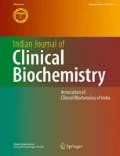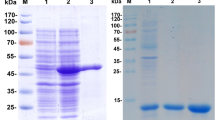Abstract
Type 1 diabetes (T1D) that accounts for about 5–10 % of all diabetes cases results from the autoimmune destruction of the insulin-producing beta cells in the pancreas. It is characterized by severe inflammatory reaction mediated by pronounced T helper type-1 response. Parasitic infections having the ability to skew the host immune responses towards type-2 type as a part of their defense mechanism are able to induce protection against autoimmune diseases like T1D. Hence, the present study is undertaken to explore a recombinant abundant larval transcript protein of the human lymphatic filarial parasite Brugia malayi (rBmALT-2), a known anti-inflammatory molecule for its therapeutic effect on streptozotocin (STZ)-induced T1D in mice. The diabetic mice on treatment with rBmALT-2 showed a significant (p < 0.0005) decrease in their fasting blood glucose levels. By the end of the second week after the initiation of treatment with the rBmALT-2, 28 % of the diabetic mice became normal and none of them were diabetic by the end of 5th week. The anti-diabetic effect of rBmALT-2 significantly correlated with the concomitant redressal of the pancreatic histopathological damage caused by STZ assault (rho = 0.87; p < 0.0005). The sera of rBmALT-2 treated diabetic mice had increased levels of IgG1 antibodies associated with decreased IgG2a antibodies against the principal autoantigen insulin. The splenocyte proliferative response and the cytokine release in the treated mice showed marked bias against inflammation skewing the immune response to Th-2 type. From this study, it can be envisaged that that filarial proteins like rBmALT-2 with effective immunomodulatory activity and anti-diabetic effect are promising alternative therapeutic agents for T1D.


Similar content being viewed by others
References
Diaz-Valencia PA, Bougnères P, Valleron AJ. Global epidemiology of type 1 diabetes in young adults and adults: a systematic review. BMC Public Health. 2015;15(1):1.
Atkinson MA, Eisenbarth GS, Michels AW. Type 1 diabetes. Lancet. 2014;383(9911):69–82.
Pescovitz MD, Greenbaum CJ, Krause-Steinrauf H, Becker DJ, Gitelman SE, Goland R, et al. Rituximab, B-lymphocyte depletion, and preservation of beta-cell function. N Engl J Med. 2009;361(22):2143–52.
Evert AB. Treatment of mild hypoglycemia. Diabetes Spectr. 2014;27(1):58–62.
Liu Z, Liu Q, Bleich D, Salgame P, Gause WC. Regulation of type 1 diabetes, tuberculosis, and asthma by parasites. J Mol Med. 2010;88(1):27–38.
Osada Y, Yamada S, Nabeshima A, Yamagishi Y, Ishiwata K, Nakae S, et al. Heligmosomoides polygyrus infection reduces severity of type 1 diabetes induced by multiple low-dose streptozotocin in mice via STAT6-and IL-10-independent mechanisms. Exp Parasitol. 2013;135(2):388–96.
Mishra PK, Patel N, Wu W, Bleich D, Gause WC. Prevention of type 1 diabetes through infection with an intestinal nematode parasite requires IL-10 in the absence of a Th2-type response. Mucosal Immunol. 2013;6(2):297–308.
Saunders KA, Raine T, Cooke A, Lawrence CE. Inhibition of autoimmune type 1 diabetes by gastrointestinal helminth infection. Infect Immun. 2007;75(1):397–407.
Cooke A, Tonks P, Jones FM, O’SHEA HE, Hutchings P, Fulford AJ. Infection with Schistosoma mansoni prevents insulin dependent diabetes mellitus in non-obese diabetic mice. Parasite Immunol. 1999;21(4):169–76.
Hübner MP, Thomas Stocker J, Mitre E. Inhibition of type 1 diabetes in filaria-infected non-obese diabetic mice is associated with a T helper type 2 shift and induction of FoxP3+ regulatory T cells. Immunology. 2009;127(4):512–22.
Zaccone P, Cooke A. Helminth mediated modulation of type 1 diabetes (T1D). Int J Parasitol. 2013;43(3):311–8.
McInnes IB, Leung BP, Harnett M, Gracie JA, Liew FY, Harnett W. A novel therapeutic approach targeting articular inflammation using the filarial nematode-derived phosphorylcholine-containing glycoprotein ES-62. J Immunol. 2003;171(4):2127–33.
Harnett W, McInnes IB, Harnett MM. ES-62, a filarial nematode-derived immunomodulator with anti-inflammatory potential. Immunol Lett. 2004;94(1):27–33.
Amdare N, Khatri V, Yadav RS, Tarnekar A, Goswami K, Reddy MV. Brugia malayi soluble and excretory-secretory proteins attenuate development of streptozotocin-induced type 1 diabetes in mice. Parasite Immunol. 2015;37(12):624–34.
Gomez-Escobar N, Bennett C, Prieto-Lafuente L, Aebischer T, Blackburn CC, Maizels RM. Heterologous expression of the filarial nematode alt gene products reveals their potential to inhibit immune function. BMC Biol. 2005;3(1):1.
Madhumathi J, Prince PR, Nageswara Rao D, Kaliraj P. Dominant T-cell epitopes of filarial BmALT-2 and their cytokine profile in BALB/c mice. Parasite Immunol. 2010;32(11–12):760–3.
Gnanasekar M, Rao KV, He YX, Mishra PK, Nutman TB, Kaliraj P, et al. Novel phage display-based subtractive screening to identify vaccine candidates of Brugia malayi. Infect Immun. 2004;72(8):4707–15.
Malyala P, Singh M. Endotoxin limits in formulations for preclinical research. J Pharm Sci. 2008;97(6):2041–4.
Santos RR, Sartori A, Lima DS, Souza PR, Coelho-Castelo AA, Bonato VL, et al. DNA vaccine containing the mycobacterial hsp65 gene prevented insulitis in MLD-STZ diabetes. J Immune Based Ther Vaccines. 2009;7(1):4.
Imai S, Tezuka H, Fujita K. A factor of inducing IgE from a filarial parasite prevents insulin-dependent diabetes mellitus in nonobese diabetic mice. Biochem Biophys Res Commun. 2001;286(5):1051–8.
El-Wakil HS, Aboushousha TS, El Haddad O, Gamil NB, Mansour T, El-Said H. Effect of Schistosoma mansoni egg deposition on multiple low doses streptozotocin induced insulin dependent diabetes. J Egypt Soc Parasitol. 2002;32(3):987–1002.
Espinoza-Jiménez A, Rivera-Montoya I, Cárdenas-Arreola R, Morán L, Terrazas LI. Taenia crassiceps infection attenuates multiple low-dose streptozotocin-induced diabetes. BioMed Res Int. 2010. doi:10.1155/2010/850541.
Lund ME, O’Brien BA, Hutchinson AT, Robinson MW, Simpson AM, Dalton JP, et al. Secreted proteins from the helminth Fasciola hepatica inhibit the initiation of autoreactive T cell responses and prevent diabetes in the NOD mouse. PLoS One. 2014;9(1):e86289.
Kazura JW, Nutman TB, Greene BM. Filariasis. In: Warren KS, editor. Immunology and molecular biology of parasitic infections. Oxford: Blackwell Scientific Publications Ltd; 1993. p. 473–95.
Wu Y, Egerton G, Pappin DJ, Harrison RA, Wilkinson MC, Underwood A, et al. The secreted larval acidic proteins (SLAPs) of Onchocerca spp. are encoded by orthologues of the alt gene family of Brugia malayi and have host protective potential. Mol Biochem Parasitol. 2004;134(2):213–24.
Aravindhan V, Mohan V, Surendar J, Rao MM, Pavankumar N, Deepa M, et al. Decreased prevalence of lymphatic filariasis among diabetic subjects associated with a diminished pro-inflammatory cytokine response (CURES 83). PLoS Negl Trop Dis. 2010;4(6):e707.
Khatri V, Amdare N, Tarnekar A, Goswami K, Reddy MV. Brugia malayi cystatin therapeutically ameliorates dextran sulfate sodium-induced colitis in mice. J Dig Dis. 2015;16(10):585–94.
Acknowledgments
This research work was supported by the funding received from Department of Biotechnology (DBT) (Project Id. BT/PR/4988/INF/22/155/2012) and Department of Science and Technology (DST-FIST) (Project Id. SR/FST/LSI-470/2010) of Ministry of Science and Technology, Government of India. The authors are also thankful to Indian Council of Medical Research, Government of India for the STS Fellowship support to the first author.
Author information
Authors and Affiliations
Corresponding author
Ethics declarations
Conflict of interest
All the authors have declared that they have no conflict of interest.
Ethical Approval
This study does not contain any studies with human participants performed by any of the authors. This study was approved by Institutional Animal Ethics Committee and national guidelines as per Committee for the Purpose of Control and Supervision of Experiments on Animals (CPCSEA) for the care and use of animals were followed.
Rights and permissions
About this article
Cite this article
Reddy, S.M., Reddy, P.M., Amdare, N. et al. Filarial Abundant Larval Transcript Protein ALT-2: An Immunomodulatory Therapeutic Agent for Type 1 Diabetes. Ind J Clin Biochem 32, 45–52 (2017). https://doi.org/10.1007/s12291-016-0572-y
Received:
Accepted:
Published:
Issue Date:
DOI: https://doi.org/10.1007/s12291-016-0572-y




